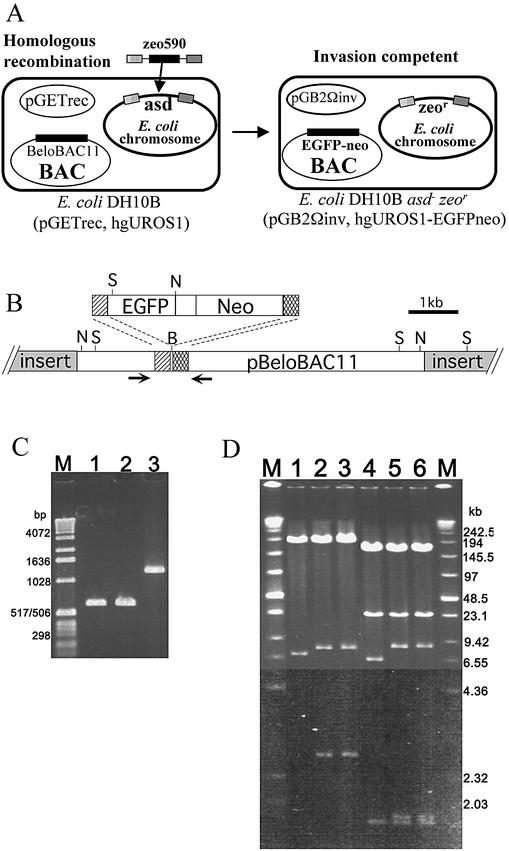Figure 1.
GET recombination in E.coli DH10B. (A) Modification of the E.coli chromosome. The zeo590 PCR product contains the zeo-resistance gene flanked at both ends with 50 bp sequences (stippled boxes) that are homologous to regions of the asd gene. Introduction of zeo590 into arabinose-induced E.coli (pGETrec) results in precise replacement of the asd gene with the zeo-resistance gene. After elimination of pGETrec, introduction of pGB2Ωinv encoding the Y.pseudotuberculosis inv gene confers the ability to invade mammalian cells and deliver either pEGFP-N2 or a modified BAC clone. (B) Modification of a 200 kb BAC clone. PCR product, EGFPneo, which contains the EGFP-kmr-neor cassette flanked on either side by 60 bp of DNA homologous to pBeloBAC11 vector centered on the Bst11701 site. Homologous recombination results in insertion of DNA encoding for EGFP and neomycin resistance. Arrows represent primers KF and KR which flank the recombination junction. B, Bst11071; N, NotI; S, SalI. (C) PCR analysis of E.coli DH10B asd–. Primers asd1 and asd2 amplify across the asd locus in E.coli DH10B. Lanes 1 and 2, the predicted 691 bp PCR product confirming correct targeted replacement of the asd locus in two independent zeor colonies. Lane 3, the 1.3 kb fragment predicted for an intact asd locus. Lane M, marker X (Roche Diagnostics Corporation, IN). (D) Restriction analysis of the modified BAC clone. Lane 1, unmodified BAC digested with NotI, showing 6.9 kb NotI fragment. Lanes 2 and 3, independent isolates of modified BAC digested with NotI showing 7.8 and 2.7 kb NotI fragments, which confirm the correct targeting of EGFPneo into the vector portion of the BAC clone. Lane 4, unmodified BAC digested with SalI showing a 6.7 kb SalI fragment. Lanes 5 and 6, independent isolates of modified BAC digested with SalI, showing 8.2 and <2 kb SalI fragments, which confirm the correct targeting of EGFPneo into the vector portion of the BAC clone. The 200 kb NotI and 175 and 24 kb SalI fragments representing the BAC insert have not changed during the homologous recombination. Higher contrast was used on the gel photograph below the 6.55 kb marker for clarity of the lower molecular weight ethidium bromide stained bands.

